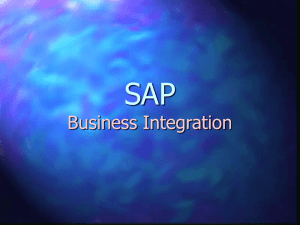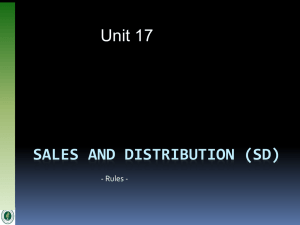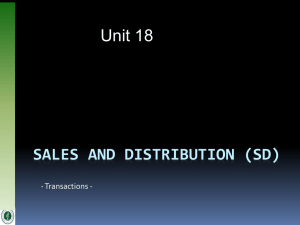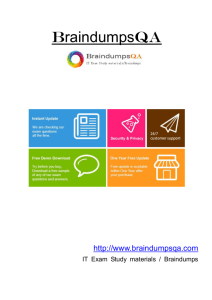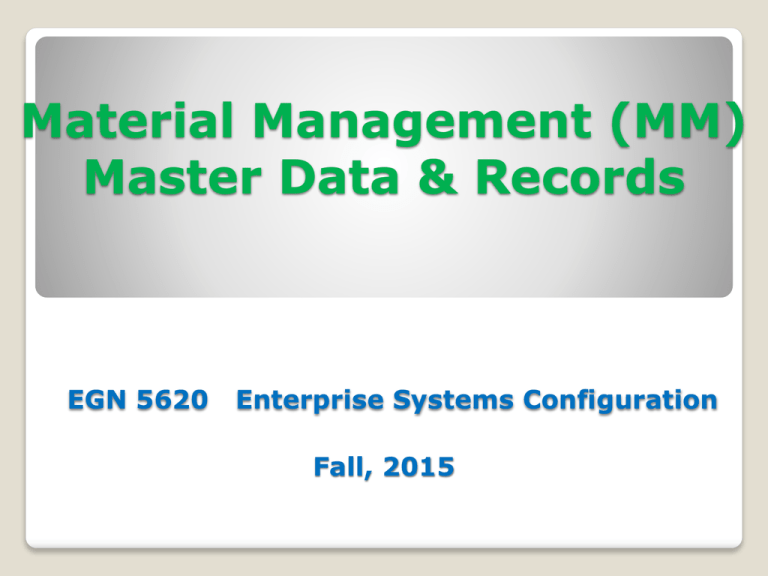
Material Management (MM)
Master Data & Records
EGN 5620
Enterprise Systems Configuration
Fall, 2015
MM Master Data & Records
SAP MM Master Data and Records
Material Data
Definition
Generic classification(material types) :
◦ Physical objects to buy, transform into (e.g.
manufacture), sell, maintain other resources, or
use in support for business activities.
◦
◦
◦
◦
◦
◦
Trading goods
Raw materials
Semi-finished products (WIPs)
Finished products
Consumables (e.g., stationery, production tools)
Spare parts (for maintenance)
Material Data
Typical material attributes, by business
functions:
•
•
•
•
•
•
•
•
•
Industry sector
Basic
Purchase
Sales
Work scheduling (Production)
MRP (Inventory)
Warehousing
Accounting
Costing
MM Master Data
January 2008
© SAP AG - University Alliances and
The Rushmore Group, LLC 2008. All
rights reserved.
5
MM Master Data (review)
Material master data are part of SAP master
data, which are relatively fixed.
Organizational structure must be
completed before creating the master
data
January 2008
© SAP AG - University Alliances and
The Rushmore Group, LLC 2008. All
rights reserved.
6
Master Data records (review)
Each master data record is unique
Master data records are usually created or
converted (from a legacy system) at the
beginning of SAP deployment
Material master records are maintained by
various organization units such as sales,
purchasing, production, & accounting, etc.
January 2008
© SAP AG - University Alliances and
The Rushmore Group, LLC 2008. All
rights reserved.
7
Material Master Data Modeling
Material
attributes are used to
sufficiently differentiate their:
•
•
•
•
Industry sector
Material type
organizational levels
various business views
January 2008
© SAP AG - University Alliances and
The Rushmore Group, LLC 2008. All
rights reserved.
8
Material Master – Industry Sector
Industry sector is used to group
records
It determines industry-specific data that
will appear on the master record
Industry sector examples:
•
•
•
•
•
Chemical industry (C ),
Mechanical engineering (M),
Pharmaceuticals (P),
Plant Eng./Construction (A),
Retail, and so on.
January 2008
© SAP AG - University Alliances and
The Rushmore Group, LLC 2008. All
rights reserved.
9
Material Master – Material Type
It defines material attributes of:
◦ Valuation
◦ Price control,
◦ etc.
It controls transaction types allowed
for the material
It controls the field selection, and
account determination.
January 2008
© SAP AG - University Alliances and
The Rushmore Group, LLC 2007. All
rights reserved.
10
Material Master – Material Type (continued)
Material type information is used to
determines:
• What views are maintained
• Whether internal or external procurement
is allowed
• Whether changes in material quantity need to
be updated
January 2008
© SAP AG - University Alliances and
The Rushmore Group, LLC 2008. All
rights reserved.
11
Material Master – Material Types
(-continued)
SAP standard material types (used in all
industries):
◦ ROH (Raw Materials)
Purchased externally only
No sales view
◦ HAWA (Trading Goods)
Always purchased externally
Sold without any change to the material
No manufacturing views exist
◦ FERT (Finished Products)
Are produced internally
Normally no purchasing views exist
◦ HALB (Semi-Finished Products)
Are produced internally
2008 views exist
Normally no purchasing and January
sales
12
Material Master
– More Material Types (-continued)
HIBE (Operating Supplies)
VERP (Customer returnable packaging)
LEER (Empty containers)
KMAT(Configurable material)
ERSA (Spare parts)
DIEN (Services)
NLAG (Non-stock, non-valuated material)
UNBW (Non-valuated, stocked material)
FHMI (Production resources/tools)
WETT (Competitive products)
PROD (Product group)
IBAU (Maintenance assembly, plant maintenance)
January 2008
© SAP AG - University Alliances and
The Rushmore Group, LLC 2008. All
rights reserved.
13
Material Master – Organization Levels
Material master data can be related to all
organizational levels
General information of material master
records (such as description, number, base unit
of measure) has to be related to the highest
level of organization (i.e., the client)
Other material master records are tailored at the
plant or lower levels
January 2008
© SAP AG - University Alliances and
The Rushmore Group, LLC 2008. All
rights reserved.
14
Material Master
– at Various Organization Levels (-continued)
Data are visible
◦ At client level:
Description
Units of measure
Material number
Engineering data
◦ At plant level:
Planning data
Manufacturing data
Purchasing data
◦ At storage location level:
Stock quantities
January 2008
© SAP AG - University Alliances and
The Rushmore Group, LLC 2008. All
rights reserved.
15
Material Master – Primary Views
Basic data 1
Sales: sales organization data 1 (for trading and finished goods)
Sales: sales organization data 2 (for trading and finished goods)
Sales: general/plant data (for trading and finished goods)
Purchasing (for trading and raw materials)
Forecasting
MRP: 1
MRP: 2
MRP: 3
Work scheduling (for finished and semi-finished goods)
General Plant Data/Storage
Accounting 1
Costing 1 (for raw, semi-finished, and finished goods)
January 2008
© SAP AG - University Alliances and
The Rushmore Group, LLC 2008. All
rights reserved.
16
Material Master – Basic Data 1 View
General data
Dimensions/EANs
◦ Basic Unit of Measure
Unit of measure in which stocks of the material are managed
◦ Material Group
Used to group together several materials or services with the
same attributes
◦ Division
Used to determine the sales area and the business area for a
material, product, or service
◦ Gross weight
Used to check storage capacity in warehouse
◦ Net weight
Weight excluding packaging and extras – this is needed for
sales and distribution
◦ Weight Unit
Unit of Measure for weight
◦ Volume
© SAP AG - University Alliances and
The Rushmore
Group, LLC 2008. All
The space that the material occupies
per unit
of volume
January 2008 rights reserved.
17
Material Master
– Sales View 1: Sales Organization
General Data
◦ Base Unit of Measure
The Base Unit of Measure is the unit of measure in which
stocks are managed within your company.
◦ Division
You may enter the Division which your product is in for sales
(defaults if entered in the Basic data screen).
◦ Material Group
A key that’s used to group several materials or services for
analysis/reporting as well as search by match code.
◦ Sales Unit
The unit of measure in which the material is sold, if left blank
then uses the base unit of measure.
January 2008
© SAP AG - University Alliances and
The Rushmore Group, LLC 2008. All
rights reserved.
18
Material Master
– Sales View 1: Sales Organization
◦ Delivering Plant
Plant from which the material is available for sale.
◦ Cash discount
Indicator used for materials, which allow for a
cash discount.
◦ Conditions
Pricing procedure for the material
Tax Data
◦ Tax classification material
The indicator with which the system determines
output tax for the material when processing sales
and distribution-specific documents
January 2008
© SAP AG - University Alliances and
The Rushmore Group, LLC 2008. All
rights reserved.
19
Material Master
– Sales View 2: Sales Organization
Grouping Terms
◦ Material Statistics Group
Determine which data the system updates in the logistics
information system
◦ Material Pricing Group
A way of grouping materials to which you want to apply
the same conditions
◦ Volume Rebate Group
Group definition used for rebate settlement.
◦ General Item Category Group
Materials grouping that helps the system to determine
item categories during sales document processing.
◦ Item Category Group
A grouping of materials that the system uses to
determine item categories during the processing of sales
documents.
◦ Commission Group
Commission group to which the material
is- University
assigned.
© SAP AG
Alliances and
January 2008
The Rushmore Group, LLC 2008. All
rights reserved.
20
Material Master
– Sales View: General/Plant View
General Data
◦ Base unit
The unit of measure in which items are managed in
the company
◦ Gross weight
Used to check storage capacity in warehouse
◦ Net weight
Weight excluding packaging and
extras – this is needed
for sales and distribution
◦ Availability check
Option to do an availability
check for orders and MRP
January 2008
© SAP AG - University Alliances and
The Rushmore Group, LLC 2008. All
rights reserved.
21
Material Master
– Sales View: General/Plant View
Shipping Data (times in days)
◦ Transportation Group
Defines materials that have the same transportation
requirements. For example, bulk stock materials
◦ Loading Group
Defines materials that have the same loading
requirements, such as forklift truck, or crane.
Packaging Material Data
◦ Material group Pack Materials
Materials that require similar packaging materials
General Plant Parameters
◦ Negative stock
It indicates if negative stocks of the material are allowed
at the plant
◦ Profit Center
It identifies the profit center in the current controlling
area
© SAP AG - University Alliances and
January 2008
The Rushmore Group, LLC 2008. All
rights reserved.
22
Material Master – Purchasing View
General Data
• Order Unit
• The unit of measure in which a company
purchases the product
• Purchasing Group
• Key for a buyer or a group of buyers, who is/are
responsible for certain purchasing activities.
Purchasing Values
• Purchasing Value Key
• It defines the reminder days and tolerance limits
for purchasing
January 2008
© SAP AG - University Alliances and
The Rushmore Group, LLC 2008. All
rights reserved.
23
Material Master – Forecasting View
Number of Periods Required
◦ Historical Periods
The number of historical values the system uses
for the forecast
◦ Forecast Periods
Number of period splits for which a forecast
should be created
Forecast Values
◦ The numeric quantity for future periods
Consumption Values
◦ The sum of planned and unplanned
consumption
24
Material Master – MRP View 1
General Data
◦ Purchasing Group
The buyer(s) who are responsible for certain purchasing
activities
MRP Procedures
◦ MRP Type
It determines whether and how the material is planned
◦ Reorder Point
If stock falls below this point, the system is flagged to create
a planned order
◦ MRP Controller
The person(s) responsible for the material planning
Lot Size Data
◦ Lot Size
The lot sizing procedure to calculate the quantity to be
produced or procured
◦ Minimum Lot Size
The smallest order quantity
◦ Fixed Lot Size
© SAP AG - University Alliances and
The quantity to be ordered
January 2008
The Rushmore Group, LLC 2008. All
rights reserved.
25
Material Master – MRP View 1
January 2008
© SAP AG - University Alliances and
The Rushmore Group, LLC 2008. All
rights reserved.
26
Material Master – MRP View 2
Scheduling
◦ Planned Delivery Time
Number of calendar days needed to obtain the
material
◦ Scheduling Margin Key
Used to determine the floats required for
scheduling
Net Requirement Calculation
◦ Safety Stock
It specifies the quantity of safety stock whose
purpose is to satisfy unexpectedly high demand in
the coverage period
January 2008
© SAP AG - University Alliances and
The Rushmore Group, LLC 2008. All
rights reserved.
27
Material Master – MRP View 3
Availability Check
◦ It specifies whether and how the system checks
availability and generates requirements for
materials planning
January 2008
© SAP AG - University Alliances and
The Rushmore Group, LLC 2008. All
rights reserved.
28
Material Master – Work Scheduling View
Only for finished products and semi-finished
materials
Production scheduler
Production Scheduler Profile
◦ It specifies the production scheduler
◦ It specifies production scheduler profile
January 2008
© SAP AG - University Alliances and
The Rushmore Group, LLC 2008. All
rights reserved.
29
Material Master – Plant Data/Storage View 1
General Data
◦ Container Requirements
It defines the regulations that govern which type
of container the material must be stored and
shipped in
◦ Storage Conditions
It defines the conditions on how a material must
be stored or warehoused
Shelf Life Data
◦ Minimum remaining shelf life
Minimum time the material must keep upon goods
receipt for the goods receipt to be accepted by the
system
◦ Total Shelf Life
Period of time the material will keep in total, from
the date of production or receipt to the shelf life
expiration date
© SAP AG - University Alliances and
January 2008
The Rushmore Group, LLC 2008. All
rights reserved.
30
Material Master – Accounting View 1
Current Valuation
◦ Valuation Class
• It allows the stock values of materials of the
same material type to be posted to different
G/L accounts.
• It allows the stock values of materials of
different material types to be posted to the
same G/L account.
• It determines together with other factors the
G/L accounts updated for a valuation-relevant
transaction (Material Movements)
◦ Price Unit
• Number of units to which the price refers
January 2008
© SAP AG - University Alliances and
The Rushmore Group, LLC 2008. All
rights reserved.
31
Material Master – Accounting View 1
Current Valuation
◦ Price Control Indicator
• The price control used to valuate the stock of
a material (e.g., Standard or Moving Average
Price)
◦ Standard Price
• The valuation of material stocks at standard
prices means that all goods movements are
valuated at the same price over an extended
period
◦ Moving Average Price
• The system calculates the moving average
price automatically by dividing the material
value in the stock account by the total of all
storage location stocks in the plant concerned
January 2008
© SAP AG - University Alliances and
The Rushmore Group, LLC 2008. All
rights reserved.
32
Material Master – Costing View
General Data
◦ Overhead Group
It assigns same overhead rate to group
Standard Cost Estimate
◦ Future
Planned cost of material in future
◦ Current
Current standard cost of material
◦ Previous
Historical standard cost of material
Planned Prices
Valuation Data
◦ Future price of material
◦ Valuation Class
Class type for G/L posting
January 2008
© SAP AG - University Alliances and
The Rushmore Group, LLC 2007. All
rights reserved.
33
GBI
MM
Master Data and Records
Trading Goods
Material Type Materials
Views required
Valuation
class
HAWA
EPAD10##
Basic data 1
3100
(Trading Goods)
KPAD10## Purchasing
OHMT10## MRP 1, 2, 3
RHMT10## General Plant data/Storage 1
RKIT10##
Accounting 1
Sales: Sales Org. Dta 1
Sales: Sales Org. Data 2
Sales: General/Plant data
Raw Materials
Material Type Materials
Views Required
Valuation
class
ROH
Bolt10##
Basic data 1
3000
(Raw Material)
BRKT10##
Purchasing
CHAN10##
MRP 1, 2, 3
DGAM10##
General Plant Data/Storage 1
HXNT10##
Accounting 1
LWSH10##
Costing 1
PCKG10##
PEDL10##
Finished Products
Material Type Materials
Views created
Valuation
class
FERT
DXTR10##
Basic data 1
7920
(Finished Products)
DXTR20##
Sales: Sales Org. Data 1
DXTR30##
Sales: Sales Org. Data 2
ORMN10##
Sales: General/Plant data
MRP 1, 2, 3
Working Scheduling
General Plant Data/Storage
Accounting 1
Costing 1
Semi-Finished Products
Material Type Materials
Views created
Valuation
class
HALB
Basic data 1
7900
(Semi-Finished
Products)
TRWA10##
MRP 1, 2, 3
Working Scheduling
General Plant Data/Storage
Accounting 1
Costing 1
Example: Moving Average Price
1) ABC International has 1,000 green widgets in stock as of the
beginning of April, at a cost per unit of $5.
2) It sells 250 of these units on April 5, and records a charge to
the cost of goods sold of $1,250, which is calculated as 250
units x $5 per unit. This means there are now 750 units
remaining in stock, at a cost per unit of $5 and a total cost of
$3,750.
3) ABC then purchases 250 additional green widgets on April 10
for $6 each (total purchase of $1,500). The moving average
cost is now $5.25, which is calculated as a total cost of $5,250
divided by the 1,000 units still on hand.
4) ABC then sells 200 units on April 12, and records a charge to
the cost of goods sold of $1,050, which is calculated as 200
units x $5.25 per unit. This means there are now 800 units
remaining in stock, at a cost per unit of $5.25 and a total cost
of $4,200.
Exercises: (Due date 9/28/2015)
1. Create primary cost elements
2. Create secondary cost elements
3. Create cost element groups
4. Open period for variant
5. Close period
6. Review accounts
7. Display balance I
8. Enter G/L account posting
9. Display balance II
10.Determine tax version
11.Define tax accounts
12.Configure automatic posting for materials
13.Maintain default values for tax codes
14.Set tolerance limits for price variance
15.Set tolerance limits for goods receipt
16.Set tolerance limits for invoice
Exercises:
17. Define tolerances (vendors)
18. Default values for inventory
19. Default values foe plants
20. Define attributes of material types
21. Create trading goods

